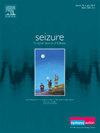Expert opinion on use of vagus nerve stimulation therapy in the management of pediatric epilepsy: A Delphi consensus study
IF 2.7
3区 医学
Q2 CLINICAL NEUROLOGY
引用次数: 0
Abstract
Purpose
To provide consensus-based recommendations for use of vagus nerve stimulation (VNS) therapy in the management of pediatric epilepsy.
Methods
Delphi methodology with two rounds of online survey was used to build consensus. A steering committee developed 43 statements related to pediatric epilepsy and the use of VNS therapy, which were evaluated by a panel of 12 neurologists/neurosurgeons with expertise in pediatric epilepsy, who graded their agreement with each statement on a scale of 1 (“I do not agree at all”) to 5 (“I strongly agree”). For each statement, consensus was established if ≥70% of the agreement scores were 4 or 5 and <30% were 1 or 2 in the final survey.
Results
Twenty-four statements regarding the need for seizure reduction in pediatric epilepsy, the recommended treatment algorithm, the benefits and safety of VNS therapy, management of side effects of VNS therapy, patient selection for VNS therapy, and the use, dosing, and titration of VNS therapy achieved consensus. VNS and other neuromodulation therapies should be considered for pediatric patients with drug-resistant epilepsy who are not candidates for resective surgery, or who do not remain seizure free after resective surgery. When VNS therapy is initiated, the target dose range should be achieved via the fastest and safest titration schedule for each patient. Scheduled programming can be helpful in dose titration.
Conclusion
The expert consensus statements represent the panelists’ collective opinion on the best practice use of VNS therapy to optimize outcomes in the management of pediatric epilepsy.
迷走神经刺激疗法用于治疗小儿癫痫的专家意见:德尔菲共识研究。
目的:为迷走神经刺激疗法(VNS)治疗小儿癫痫提供基于共识的建议:方法:采用德尔菲法和两轮在线调查来达成共识。指导委员会制定了 43 项与小儿癫痫和 VNS 治疗相关的声明,由 12 名具有小儿癫痫专业知识的神经科/神经外科医生组成的小组对这些声明进行了评估,他们对每项声明的同意程度从 1 分("我完全不同意")到 5 分("我非常同意")不等。对于每项陈述,如果≥70%的同意分数为 4 分或 5 分,则达成共识:结果:就减少小儿癫痫发作的必要性、推荐的治疗算法、VNS 治疗的益处和安全性、VNS 治疗副作用的管理、VNS 治疗患者的选择以及 VNS 治疗的使用、剂量和滴定等方面的 24 项声明达成了共识。对于不适合接受切除手术或切除手术后癫痫发作仍未得到控制的耐药癫痫儿科患者,应考虑使用 VNS 和其他神经调控疗法。开始使用 VNS 治疗时,应通过最快、最安全的滴定计划为每位患者设定目标剂量范围。定时编程有助于剂量滴定:专家共识声明代表了专家组成员对使用 VNS疗法优化小儿癫痫治疗效果的最佳实践的集体意见。
本文章由计算机程序翻译,如有差异,请以英文原文为准。
求助全文
约1分钟内获得全文
求助全文
来源期刊

Seizure-European Journal of Epilepsy
医学-临床神经学
CiteScore
5.60
自引率
6.70%
发文量
231
审稿时长
34 days
期刊介绍:
Seizure - European Journal of Epilepsy is an international journal owned by Epilepsy Action (the largest member led epilepsy organisation in the UK). It provides a forum for papers on all topics related to epilepsy and seizure disorders.
 求助内容:
求助内容: 应助结果提醒方式:
应助结果提醒方式:


